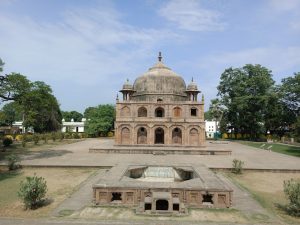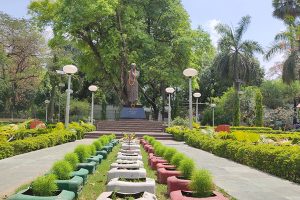Prayagraj
Prayagraj, formerly Allahabad, also known as Ilahabad, is a metropolis in the Indian state of Uttar Pradesh. It is the administrative headquarters of the Allahabad district—the most populous district in the state and 13th most populous district in India—and the Allahabad division.

in modern-day Prayagraj is believed to be the most important pilgrimage centre for Hindus. Traditionally river confluences are regarded as auspicious places, but in Sangam, the significance of the confluence is most pious because here, the holy Ganga, Yamuna and the mythical Saraswati meet to become one.
Khusro Bagh, Prayagraj

Khusro Bagh is a large walled garden and burial complex located in muhalla Khuldabad, close to the Allahabad Junction railway station, in Prayagraj, India. It is roughly 6 km from the Akbar fort built-in. It is situated over forty acres and shaped like a quadrangle.
Khusro Bagh is a large historical garden, in which tombs of Prince Khusro, the eldest son of Emperor Jahangir and Sultan Begum are located. The three sandstone mausoleums within this walled garden, represent an exquisite example of Mughal architecture.
Akbar Fort, Prayagraj :

Allahabad Fort is a fort built by the Mughal emperor Akbar at Allahabad, Uttar Pradesh, India in 1583.
For a long time [Akbar’s] desire was to found a great city in the town of Piyag [Prayag], where the rivers Ganges and Jamna join, and which is regarded by the people of India with much reverence, and which is a place of pilgrimage for the ascetics of that country, and to build a choice fort there.
Chandrshekhar Azad Park

Chandrashekhar Azad Park is a public park in Prayagraj, Uttar Pradesh, India. Built in 1870 to mark Prince Alfred’s visit to the city, with an area of 133 acres, it is the biggest park in Prayagraj.
Known for his organizational skills, Azad played a key role in reorganizing the HRA as the Hindustan Socialist Republican Association after most of the HRA’s members had been killed or imprisoned. His crimes had made him a wanted man, but Azad was able to elude the police and its informants for several years.

A park, 133 acres in area and situated in the heart of the city’s English quarters, Civil Lines, was built to commemorate the event. In 1931, Chandra Shekhar Azad, a revolutionary freedom fighter was engaged in a fierce gun fight with the British in this park. Aged 24, Azad died here on 27 February 1931.
